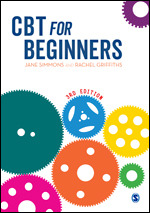CBT for Beginners
- Jane Simmons - Practising Clinical Psychologist
- Rachel Griffiths - Practising Clinical Psychologist
This book provides the ideal starting point for trainees and practitioners needing a no-nonsense, clear guide to the basics of CBT. It will equip them with the knowledge and know-how, covering all the main theory and competencies to help them practice CBT effectively and confidently.
Focusing on case formulation, the authors show readers how to build a "picture" of each client, using their case history to inform interventions. Features such as exercises, case dialogues, summary boxes, and further reading lists help to enhance and cement learning.
This Third Edition includes updated references, further reading and exercises, and new content on:
- The difficulties and drawbacks of CBT
- The differences between formal CBT and informal CBT
- The therapeutic relationship
- Further discussion of specific formulations
- Compassionate interventions with negative thoughts.
Easily accessible by students, and bringing professional therapists up to date with full and detailed practical guidance, Jane Simmons and Rachel Griffiths present both an introduction and the current state of the art application of CBT. In their third edition, the authors have achieved the very difficult aim of making a practitioner guide to the most effective evidence-based approaches a pleasure to read.
CBT for Beginners explains how to deliver CBT to young people and adults in a simple and easy to understand manner. It is an excellent resource for students, beginning psychologists and health professionals.
The latest edition of this book retains the clarity of explanation and width of content required to continue as the best introductory text to CBT available. The content is accessible and understandable to the novice practitioner and the use of case examples clearly articulate how theory is applied in practice. This edition updates information on relevant legislation and treatment advances, and is a must for any student commencing a CBT related programme.
Clear, contemporary overview and guide to the principles of CBT and introduction in to practice
An enjoyable book which is easy to understand for those just starting out on a CBT course.
A good overview of CBT and a good baseline starting book. Students have liked the simplistic approach to enable understanding of the topic of CBT. A book I will definitely use in the future.
Written in a format that is user-friendly.Great for students, tutors and practitioners.
A very well structured book, and perfect introduction to CBT basics for healthcare professionals.
This is such a good book. CBT textbooks can often bamboozle, but this strikes just the right balance between theory and practice, with a strong emphasis on case formulation and ongoing learning. Supplemented by helpful further reading lists, tools and templates. Perhaps the most comprehensive beginners' CBT title on the market.

 Sage College Publishing
Sage College Publishing








